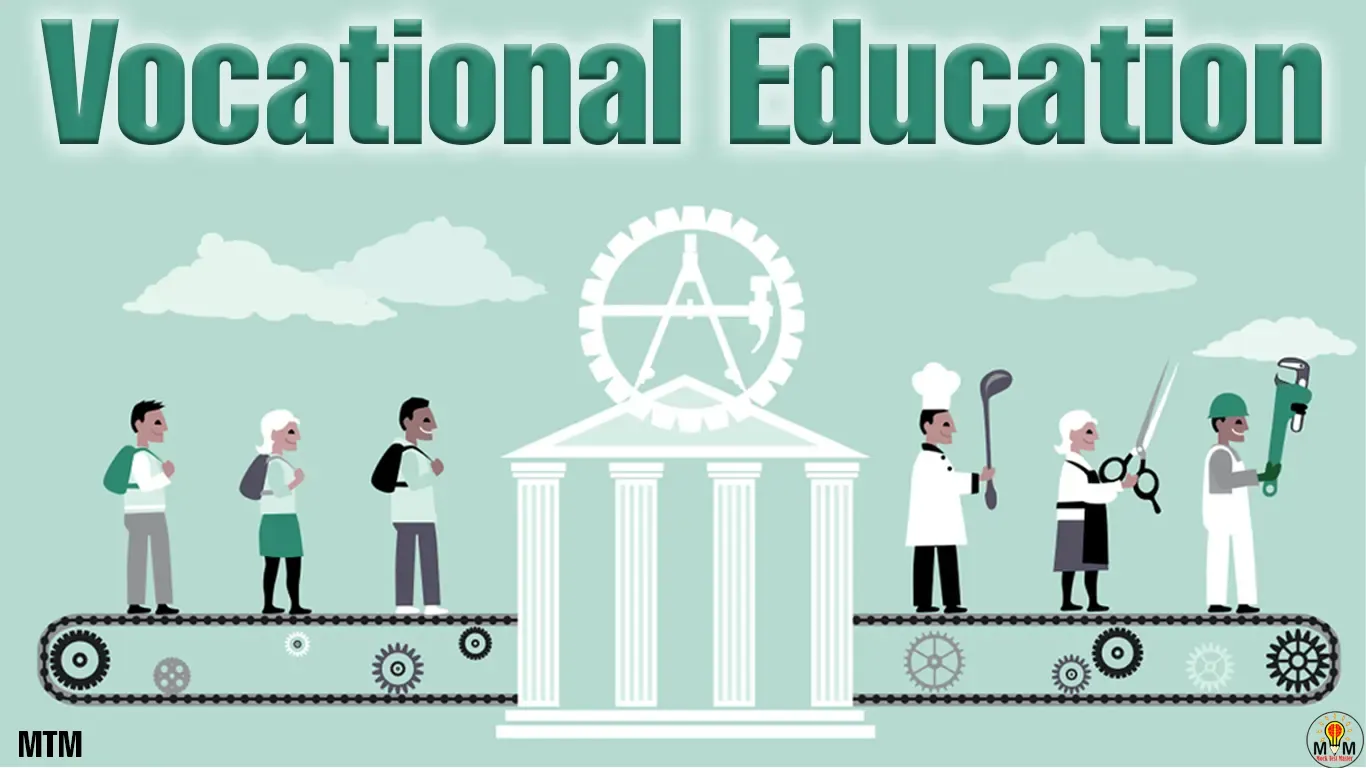Vocational education plays a crucial role in equipping individuals with the skills and knowledge required to excel in various industries. While traditional academic education remains important, vocational education offers a more practical and hands-on approach to learning. This article explores the importance of vocational education in today's society and its impact on career development, addressing the skills gap, promoting entrepreneurship and innovation, enhancing economic growth, and creating job opportunities.
Additionally, it addresses the challenges and
solutions in implementing vocational education programs. By understanding the
significance of vocational education, we can better appreciate its contribution
to shaping the future workforce and fostering a skilled and resilient society.
1. Introduction to Vocational Education
The Definition and Purpose of Vocational Education
Vocational education, also known
as career and technical education (CTE), is a type of learning that focuses on
providing practical skills and knowledge required for specific occupations. The
purpose of vocational education is to prepare individuals for the workforce by
equipping them with relevant skills, competencies, and industry-specific
knowledge.
A Brief History of Vocational Education
Vocational education has a long
history, with roots dating back to ancient times when apprenticeships were
prevalent. However, it gained significant momentum during the Industrial
Revolution, as the need for skilled workers grew rapidly. Since then,
vocational education has evolved to adapt to changing industries and
technological advancements.
The Importance of Vocational Education in Modern Society
In today's society, vocational
education plays a crucial role in addressing the demands of a rapidly evolving
job market. It provides individuals with practical skills, enabling them to
enter the workforce more quickly and effectively. Vocational education also offers
an alternative to traditional academic paths and allows individuals to pursue
careers in various fields, including trades, healthcare, technology, and more.
You Should Read: Best Career Options
2. Advantages of Vocational Education
Practical Skill Development through Hands-On Training
One of the primary advantages of
vocational education is the emphasis on hands-on training. Students engage in
practical learning experiences that simulate real-world work environments. This
approach allows them to develop and refine the specific skills necessary for
their chosen profession.
Increased Employability and Job Placement Rates
Vocational education equips
individuals with job-specific skills that make them highly desirable to
employers. With industry-aligned training, vocational students are often in
high demand, leading to increased employability and higher job placement rates
compared to those with only academic qualifications.
Cost-Effectiveness and Time Efficiency Compared to Traditional Education
Vocational education offers a
more cost-effective and time-efficient educational pathway compared to
traditional four-year degrees. By focusing on specific skills and competencies,
vocational programs are typically shorter in duration and more affordable,
allowing individuals to enter the workforce sooner with less student debt.
You Should Read: How to Get Good
Marks in Competitive Exams
3. Impact of Vocational Education on Career Development
Matching Skills with Industry Demand
Vocational education programs are
designed to align with the needs of industries. By closely matching the skills
taught with the demands of the job market, vocational education ensures that
graduates are equipped with the relevant expertise sought by employers,
increasing their chances of securing meaningful employment.
Opportunities for Career Advancement and Specialization
Vocational education provides a
solid foundation for career advancement and specialization. As individuals gain
experience and expertise in their chosen field, they can pursue further
vocational training or educational pathways to enhance their skills, opening up
opportunities for higher-paying positions and increased job satisfaction.
Exposure to Real-World Work Environments through Internships and
Apprenticeships
Vocational education often
incorporates internships and apprenticeships, offering students valuable
exposure to real-world work environments. These experiences provide hands-on
learning opportunities, allowing students to apply their knowledge and skills
in practical settings, fostering a smoother transition into the professional
world.
You Should Read: How to Polish
Your Resume Without Lying
4. Addressing the Skills Gap through Vocational Education
The Growing Skills Gap and its Implications
The skills gap refers to the
mismatch between the skills demanded by employers and those possessed by job
seekers. As industries evolve, the demand for specialized skills increases.
However, traditional educational institutions may struggle to keep pace with
these evolving needs, leading to a significant skills gap that inhibits
economic growth and productivity.
Vocational Education as a Solution to Bridge the Skills Gap
Vocational education plays a
vital role in bridging the skills gap by providing industry-relevant training
and catering to the specific demands of the job market. By focusing on
practical skills and aligning education with industry needs, vocational
programs ensure that graduates possess the competencies required to meet the
evolving demands of the workforce.
Collaboration between Vocational Institutions and Industries
To maximize the impact of
vocational education in addressing the skills gap, collaboration between
vocational institutions and industries is essential. By working together, these
entities can align curriculum, share resources, and foster partnerships that
enhance the development of relevant skills, benefiting both students and
employers alike. Collaboration ensures that vocational education remains
responsive to industry needs and facilitates a seamless transition from
education to employment.
5. Promoting Entrepreneurship and Innovation in Vocational Education
Fostering Creativity and Critical Thinking Skills
Vocational education goes beyond
teaching practical skills; it also nurtures creativity and critical thinking.
By encouraging students to think outside the box and explore innovative
solutions, vocational education prepares them for the challenges of the modern
workforce. Whether it's designing a new product or developing efficient
processes, creativity, and critical thinking are vital skills that can drive
entrepreneurship and innovation.
You Should Read: Personal Skills for Resume
Encouraging Entrepreneurial Mindset and Start-Up Ventures
Vocational education instills an
entrepreneurial mindset, empowering students to take risks and pursue their own
ventures. By providing them with the necessary knowledge and skills, vocational
education equips students with the confidence to start their own businesses and
contribute to economic growth. Whether it's opening a restaurant, launching a
tech startup, or becoming a freelance designer, vocational education sets the
stage for entrepreneurial success.
Integration of Technology and Innovation in Vocational Training
In today's digital age,
technology, and innovation are transforming industries at an unprecedented pace.
Vocational education recognizes this and integrates technology into its
training programs. By staying up-to-date with the latest advancements,
vocational education ensures that students are equipped with the skills needed
to excel in the digital economy. From coding and robotics to data analysis and
virtual reality, vocational training keeps students at the forefront of
technological innovation.
You Should Read: PSU Bank Jobs in India
6. Enhancing Economic Growth and Job Creation through Vocational Education
The Role of Vocational Education in Economic Development
Vocational education plays a
crucial role in economic development by providing the workforce with the skills
needed to drive growth in key industries. By aligning training programs with
the demands of the labor market, vocational education ensures that there is a
steady supply of skilled workers ready to meet industry needs. This, in turn,
attracts investment and promotes economic prosperity.
Job Creation and Local Workforce Empowerment
Vocational education empowers
individuals by equipping them with the skills to secure employment and
contribute to their communities. By preparing students for specific
occupations, vocational education directly addresses the skills gap and reduces
unemployment rates. Additionally, by focusing on local industries and supporting
local businesses, vocational education fosters job creation and strengthens the
local workforce.
Supporting Industries and Meeting Labor Market Demands
Vocational education ensures that
industries have access to a skilled labor pool, meeting their demands for
qualified workers. As industries evolve and new sectors emerge, vocational
education adapts its training programs to match the shifting needs of the labor
market. By producing a workforce equipped with the right skills, vocational
education supports industries, boosts productivity, and drives economic growth.
7. Challenges and Solutions in Implementing Vocational Education Programs
Funding and Resource Allocation for Vocational Education
One of the primary challenges in
implementing vocational education programs is securing sufficient funding and
allocating resources effectively. To address this, governments and education
institutions need to prioritize vocational education and allocate adequate
financial resources to ensure its success. Additionally, partnerships with
private sector organizations can help bridge funding gaps and provide students
with access to industry-specific training facilities and equipment.
Changing Perceptions and Societal Stigma Surrounding Vocational
Education
A significant challenge facing
vocational education is the societal stigma often associated with it. Many
people hold the misconception that vocational education is inferior to
traditional academic pathways. To overcome this, it is essential to change
perceptions and highlight the valuable skills and career opportunities
vocational education provides. Promoting success stories of individuals who
have thrived through vocational education can help shift societal attitudes and
encourage more students to consider vocational training.
Improving Collaboration between Education Institutions and Industry
Partners
Effective collaboration between
education institutions and industry partners is crucial for the success of
vocational education programs. By working closely with industry professionals
and employers, vocational education providers can ensure that their training
aligns with current industry needs. Establishing partnerships and internships
with businesses can also provide students with real-world experience and
enhance their employability. Strengthening these collaborations can bridge the
gap between education and industry, making vocational education more impactful.
You Should Read: Top Competitive Exams after 12th
8. Conclusion: The Role of Vocational Education in Shaping the Future Workforce
Vocational education plays a
vital role in shaping the future workforce by promoting entrepreneurship,
fostering innovation, enhancing economic growth, and addressing labor market
demands. By equipping individuals with practical skills, vocational education
empowers them to succeed in various industries and contribute to economic
development. Through effective collaboration, resource allocation, and changing
societal perceptions, vocational education can overcome challenges and continue
to play a crucial role in preparing individuals for the evolving world of work.
In conclusion, vocational
education plays a vital role in preparing individuals for success in the modern
workforce. By providing practical skills, matching industry demand, and
fostering innovation and entrepreneurship, vocational education addresses the
skills gap, enhances economic growth, and creates job opportunities. Despite the
challenges involved in implementing vocational education programs, it is clear
that investing in such initiatives is crucial for the development of a skilled
and resilient workforce. As we move forward, let us recognize and embrace the
importance of vocational education in shaping the future, ensuring a
well-equipped workforce ready to meet the evolving needs of industries and contribute
to a thriving society.
FAQ
1. What is vocational education?
Vocational education refers to
educational programs that are designed to provide individuals with the specific
skills and knowledge necessary for a particular trade or profession. It focuses
on practical training and hands-on experience, aiming to prepare individuals
for specific careers or industries.
2. How does vocational education differ from traditional academic
education?
While traditional academic
education emphasizes theoretical knowledge and general subjects, vocational
education focuses on providing practical skills directly related to a specific
occupation or industry. Vocational education programs often involve internships,
apprenticeships, and real-world work experience, allowing individuals to gain
hands-on training and a deeper understanding of their chosen field.
3. Are vocational education programs only for those who do not pursue
higher education?
No, vocational education programs
are not limited to individuals who do not pursue higher education. Vocational
education can be pursued alongside or after academic education, offering
individuals an alternative pathway to gain specialized skills and knowledge in
a specific field. Many vocational education programs also offer opportunities
for further education and career advancement.
4. How does vocational education contribute to addressing the skills
gap?
Vocational education plays a crucial role in bridging the skills gap by providing individuals with the specific skills and training needed in industries facing a shortage of skilled workers. By aligning vocational education programs with industry demands, individuals can acquire the necessary skills to meet the needs of the job market, thereby reducing the skills gap and increasing employment opportunities.




%20System.webp)

